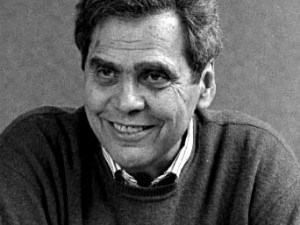 Neil Postman (March 8, 1931 – October 5, 2003) was an American author, media theorist and cultural critic, who was associated with NYU for forty years. He wrote countless articles, papers and seventeen books.
Neil Postman (March 8, 1931 – October 5, 2003) was an American author, media theorist and cultural critic, who was associated with NYU for forty years. He wrote countless articles, papers and seventeen books.
Though my personal favorite is Teaching as a Subversive Activity, Neil is best known for his 1985 book about television, Amusing Ourselves to Death. For more than forty years, he advanced the study of Media Ecology, supported humanism and believed that
“new technology can never substitute for human values.”
 Marshall McLuhan (July 21, 1911 – December 31, 1980) was a Canadian professor, philosopher, and public intellectual who’s work is viewed as one of the cornerstones of the study of media theory, as well as having practical applications in the advertising and television industries. He was educated at the University of Manitoba and the University of Cambridge and began his teaching career as a Professor of English at several universities in the U.S. and Canada, before moving to the University of Toronto where he would remain for the rest of his life.
Marshall McLuhan (July 21, 1911 – December 31, 1980) was a Canadian professor, philosopher, and public intellectual who’s work is viewed as one of the cornerstones of the study of media theory, as well as having practical applications in the advertising and television industries. He was educated at the University of Manitoba and the University of Cambridge and began his teaching career as a Professor of English at several universities in the U.S. and Canada, before moving to the University of Toronto where he would remain for the rest of his life.
McLuhan coined the expressions
“the medium is the message”
and
“the global village”
and predicted the World Wide Web thirty years before it was invented.
McLuhan published Understanding Media in 1964, which focuses on the media effects that permeate society and culture. McLuhan’s starting point, however, is always the individual, because he defines media as technological extensions of the body.
As a result, McLuhan often puts his inquiry and his conclusions in terms of the ratio between the physical senses (the extent to which we depend on them relative to each other) and the consequences of modifications to that ratio. This invariably entails a psychological dimension. Thus, the invention of the alphabet and the resulting intensification of the visual sense in the communication process gave sight priority over hearing, but the effect was so powerful that it went beyond communication through language to reshape literate society’s conception and use of space.
 Postman and McLuhan, each were a wild composition of deep, intellectual insight and silly quip. Each had a tremendous sense of humour, bent to their will of illustrating humanity’s folly, which fell on mostly deaf ears not intelligent enough to understand. McLuhan used his intellect as a jester would, declaring “the end of linear logic.
Postman and McLuhan, each were a wild composition of deep, intellectual insight and silly quip. Each had a tremendous sense of humour, bent to their will of illustrating humanity’s folly, which fell on mostly deaf ears not intelligent enough to understand. McLuhan used his intellect as a jester would, declaring “the end of linear logic.
Meanwhile, Postman was a verbal artist, combining his intellect and cutting, gallows humor, with insights like:
“What the advertiser needs to know is not what is right about the product but what is wrong about the buyer.”
Quite seriously, though, these two made great efforts to define media ecology as a critical point of study for the sake of human survival, a more formal discipline in the study of various media and the impact it has on culture at large. Media ecology is currently defined as:
arranging various media to help each other so they won’t cancel each other out, to buttress one medium with another. You might say, for example, that radio is a bigger help to literacy than television, but television might be a very wonderful aid to teaching languages. And so you can do some things on some media that you cannot do on others. And, therefore, if you watch the whole field, you can prevent this waste that comes by one canceling the other out.
Inspired by McLuhan, Neil Postman founded the Program in Media Ecology at New York University in 1971, now a component of their Steinhardt School’s Department of Media, Culture and Communication.
Postman described the discipline as:
Media ecology looks into the matter of how media of communication affect human perception, understanding, feeling, and value; and how our interaction with media facilitates or impedes our chances of survival. The word ecology implies the study of environments: their structure, content, and impact on people.